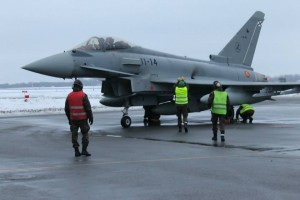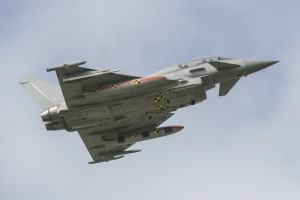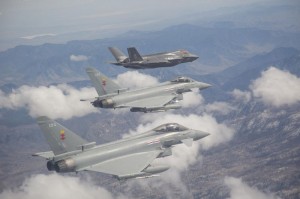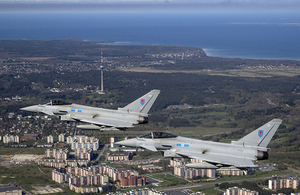2015-07-17 By Robbin Laird
Airpower has become a ubiquitous enabler of combat operations.
Indeed, air enablement is a key element of virtually every aspect of the US and its allies in operating worldwide against a variety of threats.
Airpower has evolved throughout the “land wars” to become an enabler for intelligence, strike, lift, and generally shaping more agile ground forces.
As the focus shifts from the “land wars” to challenges shaped by a variety of competitors and adversaries mixing advanced with more traditional technologies, airpower is undergoing a fundamental transformation.
Fifth generation aircraft are a major change agent in the evolving airpower dynamic.
We have argued for some time that the introduction of fifth generation aircraft into legacy fleets was part of a process we have called the “re-norming” of airpower.
We have even published a book with that title.
But we have emphasized that it is the overall air combat enterprise, which will change, not simply the introduction of a new production fighter aircraft.
This means in part that some legacy systems will simply be jettisoned, but some will be modernized as the air enterprise evolves.
All legacy aircraft are not created equal; a premium will be placed on those, which are inherently upgradeable and provide core capabilities for the evolving air enterprise.
https://sldinfo.com/the-f-35-and-legacy-aircraft-re-norming-airpower-and-the-meteor-example/
The Royal Air Force is relying on a twin transformation of the Typhoon with the F-35 to provide for its core strike capability.
This means that the modernization of the Typhoon coupled with the reshaping function, which the F-35 will bring to the reshaping of the air operations effort, are both part of the British approach to re-norming airpower.
As I wrote earlier:
The RAF is undergoing two fighter aircraft transitions at the same time.
On the one hand, the Tornado is being retired and the Typhoon is subsuming its missions. On the other hand, the F-35B is coming to the fleet and will be working with Typhoon for the period ahead.
These are three very different aircraft built in different periods of aviation history.
The venerable Tornado has seen a significant evolution over its time; from its initial use as an ultra low-level nuclear and unguided weapons bomber to an ISR-enabled precision strike and close support aircraft.

The Typhoon entered the RAF more than a decade ago as a classic air superiority fighter, but is now being asked to expand its effects and to subsume the Tornado missions.
The F-35B is entering the fleet as the Typhoon is making this transition.
This will mean that the RAF will be managing a double transition – Typhoon becoming multi-role and the F-35B operating off of land or ships to provide the fifth generation capability to the evolving RAF strike force.
It is also the case that Italy is undergoing a double transition as well.
And with the UK and Italy both re-norming under the impact of the introduction of the F-35 and the modernization of Eurofighter, cross cutting operational lessons certainly will be learned and shared in shaping an overlapping re-norming approach.
I added in another piece, a potential way to look at the Italian-UK dynamic for re-norming.
Both the UK and Italy will operate a mixed Eurofighter and F-35 fleet. Both have operated the Tornado, which is reaching the end of its service life. Both will sort through evolutions of the Eurofighter to encompass some of the mission sets for Tornado as the Tornado is retired and as the F-35 comes into the two fleets and provides the next surge for the re-working of air-led combat concepts of operations.
A key element of this transformation will be reworking the connectivity among air, sea and ground systems as well as shaping the weaponization approaches of joint and coalition forces.

In part, this is a Eurofighter transition whereby the radars are upgraded, and weapons added; in part this is the coming of the F-35 and its impact on reshaping air enabled combat operations.
And associated with this will be fundamental changes over time in C2, and the approach to strike operations.
The UK and Italy already fly together in operations through their use of Tornados and Eurofighters and have clearly shared combat learning with regard to the use of these platforms; as the F-35 comes on line this combat learning cycle will continue into the next generation of aircraft, and shaping ways to approach fifth generation warfare.
In effect, the dynamics of change for Italy and the UK will be a function of the intersection of four variables: the evolution of the Eurofighter; the impact of the F-35 and the global fleet of F-35s; changes in weaponization, and evolving C2 for strike and combat operations.
There is an inherent possibility that the UK and Italy could provide an important force for synergy in shaping concurrent approaches to evolving concepts of operations. Of course, this depends upon how effective their working relationship is and how effective cross-MOD, and cross-industrial relationships are in leveraging their working relationship.
A recent report by Justin Bronk of RUSI provides an important look at the Eurofighter modernization part of the re-norming equation. [ref]Justin Bronk, Maximsing European Combat Air Power: Unlocking the Eurofighter’s Full Potential (London: RUSI, 2015)[/ref]
The report is based on discussions with Typhoon pilots and others, and provides a look at various ways ahead with the Eurofighter as part of the European approach to re-norming airpower over the next two decades.
The numbers of operational Eurofighters and their evolving capabilities make them important elements of the defense modernization effort. A recent press release from Eurofighter highlighted the baseline achievements of the enterprise in providing for a core European capability.
Eurofighter Typhoon has now achieved more than 300,000 flying hours since the entry-into-service of its worldwide fleet. Eurofighter Jagdflugzeug GmbH confirmed the milestone today (July 17, 2015) adding that, with 571 aircraft ordered and 438 delivered, the programme has “delivered unprecedented levels of reliability”.

The first 5,000 flying hours were achieved in November 2005. 10,000 hours came in August 2006 and 20,000 in May 2007. By August 2008, the Eurofighter Typhoon fleet had surpassed 50,000 hours and 100,000 flying hours was reached in January 2011. In July 2014 the consortia announced that the 250,000 flying hour milestone had been reached while, at the same time, Eurojet, the makers of the Typhoon’s EJ200 engines, celebrated half a million flying hours on the aircraft…..
The global Eurofighter fleet now comprises 22 operating units with locations in Europe, the South Atlantic and the Middle East.
The RUSI reports highlights some core modernization requirements and opportunities for the Eurofighter.
In order to complement, and eventually take over from, Tornado in the strike and interdiction role in the RAF, Aeronautica Militare and later Luftwaffe service, the Eurofighter requires not only fleet-wide software upgrades to P1Eb standard (or equivalent), but also integration of the Storm Shadow stand-off air-launched cruise missile and the dual-mode Brimstone or Brimstone II anti-armour missile which has proved so successful in Libya and more recently over Iraq. The integration of these weapons is planned and early test flights are underway on instrumented production (test) aircraft in the UK (page 20).
Another aspect of the modernization challenge is to more effectively integrate Eurofighter into the evolving air enterprise being reshaped by distributed air operations.
To ensure that the Eurofighter can maintain the capabilities which the
Tornado, F-18 and Harrier currently provide to European air forces once the latter types are retired is only part of the challenge.
Whilst armament, software and sensor-payload upgrades required to accomplish this are known quantities, the longer-term challenge is to ensure maximum interoperability with the F-35 as it enters front-line service in the 2020s.
This challenge comprises issues including datalink security and bandwidth, communications, and sensor fusion. During Red Flag, F-22s and Eurofighters could only communicate through a Battlefield Airborne Communications Node (BACN) due to the unique communications equipment on the F-22.
Through Link 16, the Eurofighter can receive information in real time from networked ground and air assets. Whilst it does not employ the sort of centralised sensor-fusion architecture found on the F-35, and to a lesser extent the F-22, the Eurofighter’s attack and identification system (AIS) presents a combined picture to the pilot via the multifunction information distribution system (MIDS). AIS also integrates data from the Eurofighter’s own radar, PIRATE, DASS and navigational aids to present the pilot with the best possible situational awareness from an otherwise federated sensor architecture. However, this still requires a significant amount of data management on the part of the pilot and could be significantly streamlined (pages 21-22).
In our interview with Sqn Leader Hugh Nichols, he highlighted what he saw as important modernization priority for Eurofighter:
Question: Secretary Wynne made the point that modernization of legacy aircraft should be taken going forward from the perspective of working with the F-35.
How do you view that approach?
Sqn Ldr Hugh Nichols: It makes sense.

Each aircraft brings different strengths to the fight and we will fly them both, with the tactics will evolving over time.
Software modifications will undoubtedly be required in order to get the most out of each aircraft and ensure full interoperability; take Link 16 for example, where the F-35 could put out a huge amount of information.
We need to ensure that Typhoon is able to receive and display the information without overloading the pilot.
Question: Typhoons have flown for some time with F-22s and now with F-35s.
What is the impact on the Typhoon?
Sqn Ldr Hugh Nichols: It makes the Typhoon more lethal and survivable.
Today, every legacy aircraft that can fly with a Raptor clearly wishes to do so.
But there is going to come a point where they will prefer to fly with the F-35 due to the data linking capability of the F-35 and how that capability enhances the situational awareness of all aircraft in that fight.
For example, we can push information out to the legacy fleet so they know where the threats from integrated air defense platforms are and therefore they have a better understanding of where they are safe from those systems.
Modernization to enhance the range of the Eurofighter to play a wider role in a sustained air operation is clearly possible.
A variety of airframe and engine upgrades have been suggested such as thrust-vectoring engines and leading-edge root extensions (LERX) to improve the aircraft’s already formidable WVR performance, and conformal fuel tanks (CFTs) to increase range without significant drag penalties.
The CFTs can theoretically be mounted on all Tranche 3 aircraft if certified and would certainly give a boost to the aircraft’s ability to mount long-range interdiction missions.
However, the RAF has a very capable tanker fleet in the A330 MRTT and extensive experience operating with other NATO-member tankers. This means that the Typhoon’s range is more than adequate without CFTs, except in situations where aerial tanking is in critically short supply. Even without aerial refuelling, a large wing and fuselage and the ability to carry up to three supersonic external fuel tanks give the Eurofighter an impressive range. (page 22)
Its ability to carry significant ordinance externally is an important contributor to the overall ability of the air combat enterprise to deliver effects in the battlespace.

And modernization to enhance this capability is important as well.
Indeed, the combination of fifth generation aircraft operating forward with significant weapons loads of a variety of types with a modernized Eurofighter would clearly enhance European combat power.
Based on discussions with pilots, the author highlighted a core point which I have also heard from Eurofighter pilots – the big ticket upgrades are important but significant change could come from a more comprehensive effort to fill operational gaps.
Instead, pilots across the RAF, Luftwaffe and Aeronautica Militare want the small-scale problems with subsystems fixed as a priority. Whilst huge progress has been made in eradicating the majority of software and equipment bugs since the aircraft first entered service in 2003, there are still noticeable deficiencies with some subsystems such as the radios. Fixing these issues should not be nearly as capital-intensive as major modifications such as CFTs or the CAPTOR-E radar. However, they offer very significant performance gains through removing performance bottlenecks in both system architecture and pilot workload.
The report also offers an important warning about the future for multinational programs.
Real capabilities emerge from a program like the A400M by keeping the aircraft common and having modernization proceed across the fleet. This has not been the case with Eurofighter and has slowed down the modernization process.
Part of the problem surrounding the Eurofighter’s development followingits introduction into service in 2004–06 has been the substantially differing mission priorities of the four development nations. Under the original consortium arrangements, upgrades were supposed to be jointly funded and developed. This has proved a predominantly unworkable model given the significantly different operational imperatives and doctrinal role for the Eurofighter in British, German, Italian and Spanish service. (page 19).
The author concludes with the importance of modernizing the Eurofighter fleet as the F-35 enters service and, in effect, reshapes or re-norms airpower.
Developing maximum network, systems and tactical interoperability between the Eurofighter and the initially small numbers of F-35s, which will enter service throughout the 2020s, offers significantly increased combat effectiveness for both types. Each is capable of offering strengths where the other is comparatively weak.
The Eurofighter offers exceptional performance, heavy- and diverse-ordnance capacity, long-range and combat mass, whilst the F-35 will bring unmatched situational awareness, low-observable survivability in defended airspace and powerful electronic warfare capabilities. (page x).
https://www.rusi.org/downloads/assets/WHR_1-15_Maximising_European_Combat_Air_Power.pdf
Also see the following:
https://sldinfo.com/upgrading-and-modernizing-the-eurofighter-aerodynamic-upgrades/

